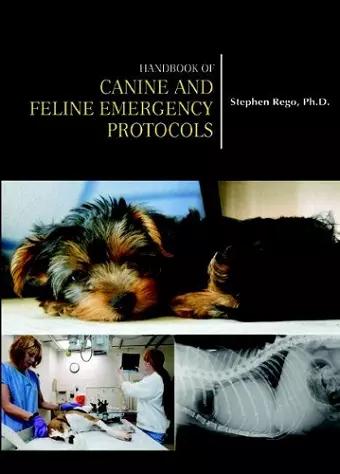Handbook of Canine and Feline Emergency Protocols
Format:Hardback
Publisher:Delve Publishing
Published:30th Nov '16
Currently unavailable, our supplier has not provided us a restock date

Canine and feline emergency protocols are important topics in veterinary medicine and will be commonly utilized by anyone entering the field. With the broad scope of topics associated with canine and feline emergency protocols this book provides an array of articles covering various topics including, trauma, cancer, diabetes, thyroid disease, skin disease, meningoencephalomyelitis, pain and inflammation and allergies. This book may interest both lay and professional individuals interested in furthering their understanding of a wide array of emergency veterinary topics. The final section of this book discusses innovative strategies that may one day be widely used in the field of emergency veterinary medicine, namely stem cells. Additionally, the utilization of animals in primary human care facilities is introduced as a way to connect pets to human health. The text is comprised of seventeen chapters. First chapter presents an overview on the application of cold intermittent pneumatic compression in the rehabilitation of multiple trauma dogs and cats or after surgery. Second chapter aimed at verifying the morphologic expression of parameters used in the cytopathological diagnosis of spontaneous OSAs in dogs of several breeds, including mixed-breeds. It also aimed at analyzing the possible concordance between cytopathological and histopathological parameters of these bone neoplasms. The aim of third chapter is to report a comparative approach of the etiological, epidemiological, pathological, and molecular aspects of melanomas in dogs. Chapter four and chapter five highlights therapeutic innovations, and the efficacy of a non-adjuvanted canarypox virus vectored vaccine and a sub-unit vaccine individually. Sixth chapter attempts to address many of the unanswered ques¬tions pertaining to osteosarcoma by focusing on recently acquired knowledge from a multi-species approach. Furthermore, the objective of the seventh chapter was to char¬acterize DM in dogs by using a mixed-effects modelling approach to identify characteristic factors and estimate their effects. Chapter eight covers the most common endocrine diseases of dogs and cats and in vitro characterization of the percutaneous absorption of tramadol into inner ear domestic feline skin using the franz skin finite dose model has been presented in ninth chapter. A prospective study on the efficacy of glucocorticoid monotherapy for treatment of canine meningoencephalomyelitis of unknown etiology is presented in chapter ten. The aim of eleventh chapter was to assess the impact of psyllium husk and the...
ISBN: 9781680958669
Dimensions: unknown
Weight: unknown
248 pages